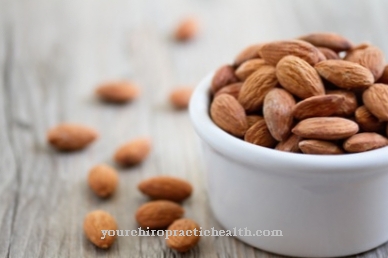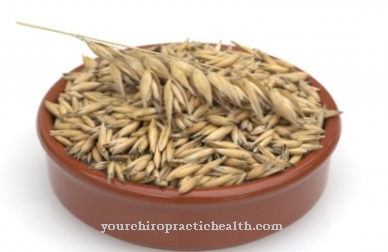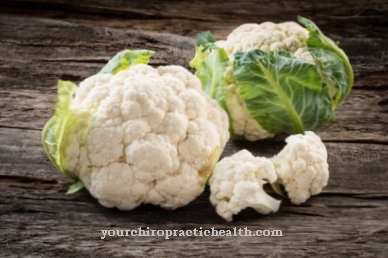Kohlrabi is one also under the name Turnip cabbage or Cabbage well-known vegetables. It belongs to the cruciferous family and is a biennial plant. Only in the second year does the tuber develop, which grows above the ground and can grow to a size of 20 centimeters.
What you should know about kohlrabi

Mainly the whitish-greenish tubers of the kohlrabi are offered for sale. But there are also bluish to dark purple varieties. The colored tubers can be found from time to time in organic shops or at particularly well-stocked vegetable gardeners.
Due to the coloring they contain anthocyanins, a coloring that can prevent cancer and can also reduce the risk of cardiovascular diseases. Domestic kohlrabi is in season from May to October. Kohlrabi is mainly grown in Central Europe and is almost only eaten here. Unlike other types of cabbage, it is not a typical winter vegetable, but rather one of the first types of vegetables that are available in spring and awaken the desire for fresh, juicy, crunchy vegetables. Kohlrabi has a slightly milder taste than other types of cabbage. The tender, fresh tubers are particularly suitable for raw vegetables.
Due to the mustard oils it contains, the kohlrabi has a light but always pleasant spiciness. Kohlrabi contains more than 90 percent water and therefore has few calories. At 100 grams there are only 23 calories, and if you are careful with the preparation of fat, kohlrabi is an ideal vegetable if you want to lose weight or save calories.
Importance to health
Kohlrabi is rich in vitamins and minerals. Vitamin A, which is very important for eyesight and also for the skin, supplies kohlrabi in sufficient quantities. Like all other types of cabbage, kohlrabi is also rich in vitamin C. It protects and strengthens the immune system and helps prevent colds.
Vitamins B1 and B2 have, among other things, a positive effect on the nerves. Niacin, the vitamin B3, is also good for nerve strength and helps with irritability. Calcium and magnesium are also among the ingredients. Because they occur together, the body can easily absorb them. Calcium is necessary for teeth and bone structure, magnesium protects the muscles and is effective against cramps. Iron is also contained in the crunchy tuber. Iron is important for blood formation. Signs of iron deficiency are severe fatigue and a drop in performance. Selenium, a cell-protecting trace element, and phosphorus, which is also indispensable for every cell, are further ingredients.
It also contains folic acid, which is particularly important for the child's healthy development during pregnancy. As healthy as the ingredients in the kohlrabi tuber are, it is very important to know that the leaves have an even higher vitamin and mineral content than the kohlrabi itself.
The use of kohlrabi leaves is therefore really recommended. The leaves contain a hundred times the amount of vitamin A than the tuber and twice the amount of vitamin C. The minerals calcium and iron are also found in much higher doses in the leaves. Fresh leaves are suitable for adding to salads.
Cut into small pieces, they can also be added to soups and other vegetable dishes. The taste of the leaves is also slightly hot. Kohlrabi contains a lot of fiber, which can fill you up and be helpful for digestion.
Ingredients & nutritional values
| Nutritional information | Amount per 100 gram |
| Calories 27 | Fat content 0.1 g |
| cholesterol 0 mg | sodium 20 mg |
| potassium 350 mg | carbohydrates 6 g |
| protein 1.7 g | Fiber 3.6 g |
Kohlrabi can do a lot for your health and wellbeing. Those who eat these vegetables regularly can protect themselves against arteriosclerosis and various cancers. Due to the high content of magnesium and calcium, kohlrabi is an ideal food for athletes, who can use it to prevent muscle cramps and sore muscles.
Vegans have to take special care to get enough calcium. Kohlrabi should be on the menu especially for vegetarians and vegans, as they contain more calcium than many other vegetables. The mustard oils contained are nitrogen and sulfur-containing chemical compounds made from amino acids, such as those found in horseradish, cress and radish.
The mustard oils are responsible for the slight heat. They have an antibacterial effect and are good for the entire urinary tract, among other things. They help with inflammation and act like herbal antibiotics. Eating kohlrabi helps with diarrhea and upset stomach. Kohlrabi juice, on the other hand, is considered a home remedy for constipation.
Intolerances & allergies
As healthy and full of valuable vitamins, trace elements and secondary plant substances as kohlrabi is, it can of course also be with these vegetables that there is a food intolerance. Histamine intolerance can also be a reason why someone should avoid kohlrabi.
Shopping & kitchen tips
When shopping, the leaves show whether the kohlrabi is freshly harvested or has been waiting for a buyer for a long time. The leaves must be nice green, fresh and not yellow, withered and limp. Kohlrabi tastes better the younger the tuber.
At the point where the leaves grow, the kohlrabi is sometimes so soft that you can easily push it in with a fingernail. Very large or overripe kohlrabi can turn woody. These parts are not edible, if the woody parts are cut out, the kohlrabi can still be used. The leaves remove moisture from the tuber. Therefore, if the kohlrabi cannot be used quickly after shopping or harvesting, it is a good idea to remove the leaves and store them separately. The leaves are far too good to throw away.
In the refrigerator, kohlrabi will keep fresh for about a week if wrapped in damp kitchen paper. Later varieties can be stored in a cellar for a few weeks without any problems.
Preparation tips
Kohlrabi must be peeled before consumption, whether raw or cooked. You may also have to cut away the woody areas. Kohlrabi taste wonderfully refreshing as raw food and can be used with other vegetable sticks to make a yoghurt dressing into a healthy and popular snack in front of the TV. As a salad, kohlrabi brings variety to everyday salad. Kohlrabi is very suitable for filling and for gratinating. It can be baked in slices.
Kohlrabi is suitable for soups, casseroles and much more. It also tastes very good in combination with peas or carrots. Steamed with a little butter or oil, kohlrabi is an ideal accompaniment to meat dishes of any kind or to fish. Of course, no meat has to be served with it. With a few fried potatoes, kohlrabi makes a wonderful vegetable meal. Kohlrabi is a vegetable that children can use to become vegetable eaters. The particularly healthy and vitamin-rich leaves of kohlrabi go perfectly with the popular green smoothies.

























.jpg)

.jpg)
